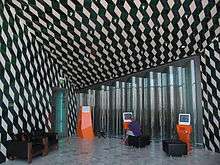Casa da Música
Coordinates: 41°09′31″N 8°37′51″W / 41.15861°N 8.63083°W
| Casa da Música | |
|
Outside view of Casa da Música | |
| General information | |
|---|---|
| Type | Concert hall |
| Town or city | Porto |
| Country | Portugal |
| Inaugurated | 15 April 2005 |
| Design and construction | |
| Architecture firm |
Rem Koolhaas/Office for Metropolitan Architecture Arup-AFA |
| Structural engineer |
Ove Arup & Partners Afassociados |
| Other information | |
| Seating capacity | 1,238+300 |
| Website | |
| Official website | |
| Casa da Música | |

Casa da Música (English: House of Music) is a major concert hall space in Porto, Portugal, which houses the cultural institution of the same name with its three orchestras Orquestra Nacional do Porto, Orquestra Barroca and Remix Ensemble. It was designed by the Dutch architect Rem Koolhaas with Office for Metropolitan Architecture in association with the agency of scenography dUCKS scéno, the acoustician Renz Van Luxemburg and Arup-AFA. Intended as part of Porto's designation as the European Culture Capital in 2001, it was only finished in 2005. It immediately became an icon in the city. Featuring a 1,300-seat auditorium suffused with daylight, it is the only concert hall in the world with two walls made entirely of glass. [1]
Credits
The Building engineers were Arup (London) together with Afassociados (Porto). Inside Outside (Petra Blaisse) designed the large 13 curtains, ranging from 22mx15m to 65mx8m, and the gold leaf wood grain pattern on the large auditorium.
Opening
Although the opening day concert took place on 14 April with performances by Clã and Lou Reed, the building was inaugurated on 15 April 2005 by the Portuguese president, when the Prime Minister and many other notable politicians and Porto society were present for a concert by the Orquestra Nacional do Porto. [2]
Construction
.1024.jpg)


Casa da Música was built just across from one of the main traffic and business centres of the city, Praça Mouzinho de Albuquerque, known as Rotunda da Boavista. The site of the building used to be a holding place for the trams that ran in Porto. Although construction ran four years over schedule and cost roughly €100M, the building process brought new engineering challenges to create its unusual configuration.
Critical reactions
The building's design has been highly acclaimed worldwide. Nicolai Ouroussoff, architecture critic from the New York Times, classified it as the "most attractive project the architect Rem Koolhaas has ever built" and saying it's "a building whose intellectual ardor is matched by its sensual beauty". He also compares it to the "exuberant design" in Frank Gehry's Guggenheim Museum in Bilbao, Spain. "Only looking into the original aspect of the building, this is one of the most important concert halls built in the last 100 years". He compares it to the Walt Disney Concert Hall, in Los Angeles, and the Berliner Philharmonie.[3]
Performance and other facilities
Casa da Música has two main auditoriums, though many other areas of the building can very easily be adapted for concerts and other musical activity (workshops, educational activities, etc.).
- The large auditorium has an initial capacity of 1,238 people, but can vary according to the occasion.
- The small auditorium is tremendously flexible, and has no definite number in relation to the capacity. On average the room has capacity for 300 people sitting down, and 650 people standing, though these can drastically change depending on the size of the stage, its location, the arrangement of the chairs, the presence and size of sound and recording equipment, etc.
- The restaurant at the top of the building was opened far later than was originally planned. Functioning since August 2006, the restaurant's original planned capacity for 250 people was decreased to space for some 150.
September 2008 Casa da Musica hosted the Orquestra Nacional do Porto taking part in explorative public presentations where performed music was captured alongside musician's and conductor's expressive gestures. Various sensor networks sourced and translated musical expressions into computer driven visual interpretations of lighting, projected images, and real-time improvisations for the audience to experience added nuance of performance. A scientific article informs on the concept.[4]
Scientific articles are also published on special needs performances/workshops in Casa da Musica 2007[5] & 2008.[6]
See also
References
- ↑ Sudjic, Deyan (10 April 2005). "'We got rid of the shoe box'". The Guardian.
- ↑ Richard Simas. "Casa Da Música Builds A Home For Experimental Music". https://www.musicworks.ca/. Musicworks. Retrieved November 22, 2015. External link in
|website=(help) - ↑ Nicolai Ouroussoff, "A Vision of a Mobile Society Rolls Off the Assembly Line", New York Times, 25 December 2005
- ↑ Icdvrat.reading.ac.uk
- ↑ Vbn.aau.dk Archived 22 May 2009 at the Wayback Machine.
- ↑ Icdvrat.reading.ac.uk
External links
| Wikimedia Commons has media related to Casa da Música. |